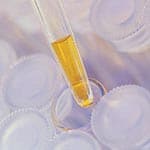Life Extension Magazine®
Startling research findings released in 2005 indicate that coenzyme Q10 may have a role in cancer treatment. Not only is there favorable human clinical data, but scientists have also discovered new anti-cancer mechanisms related to CoQ10. Coenzyme Q10 was first prescribed in Japan to treat heart disease in the 1960s.1 Beginning in the 1990s, scientists hypothesized that CoQ10 may help prevent certain brain diseases. When doctors gave high doses of CoQ10 to Parkinson’s patients, disease progression slowed by 44%.2 Scant attention was paid to a 1994 European study in which breast cancer patients were treated with CoQ10. The result of this European study was tumor regression and improved long-term survival in patients whose cancers had spread too far to be completely removed by surgery.3 CoQ10 is so closely associated with heart and brain function that few people understand its role against cancer. Scientists investigating the effects of CoQ10 have uncovered evidence that CoQ10 can selectively kill cancer cells without harming normal cells—something that conventional chemotherapy cannot do.4,5 Tamoxifen and CoQ10Tamoxifen is a drug used to treat breast cancer. Its principal mechanism is to block estrogen-receptor sites on cancer cell membranes, thereby reducing the cell-proliferating effects of estrogen. As is typical of anti-cancer drugs, tamoxifen can induce serious side effects. Scientists sought to find out whether coenzyme Q10 could improve the cell-killing effects of tamoxifen. In a study published in May 2005, rats with mammary tumors were given tamoxifen, coenzyme Q10, tamoxifen plus coenzyme Q10, or no therapy. Compared to rats receiving no therapy, those receiving either CoQ10 or tamoxifen had greatly reduced tumor weight and volume.6
The most significant tumor-suppressing effect, however, was seen in the group receiving tamoxifen plus coenzyme Q10. In this group, there was virtually no increase in tumor weight, while in the untreated group, tumor weight increased more than threefold. The scientists concluded that the addition of CoQ10 increased the susceptibility of cancer cells to tamoxifen.6 In a related study published in February 2005, mammary tumor proliferation in rats was prevented by the administration of tamoxifen plus CoQ10, niacin, and riboflavin.7 Free radicals are involved in the initiation and promotion of cancer.6,8-20 In these recent studies, rats with mammary tumors displayed elevated free radical activity and low levels of natural antioxidants such as SOD, catalase, and glutathione.6,7 The administration of nutrients such as CoQ10 with tamoxifen caused natural antioxidant levels to be greatly restored. The result was significant inhibitory effects on cancer cell proliferation. Novel Research from the University of MiamiA startling finding of CoQ10’s anti-cancer mechanism of action was discovered in recent studies conducted at the University of Miami’s Leonard M. Miller School of Medicine.21 In a July 2005 telephone interview, principal investigator Dr. S.L. Hsia told Life Extension: “This is the first time in history we have been able to selectively teach a cancer cell to kill itself with CoQ10, via a mitochondrial mechanism, without harming the healthy cells.”5 According to research director Niven R. Narain, cancer cells lose their apoptotic potential, or ability to respond to programmed cell death, but CoQ10 restores apoptotic potential to cancer cells. Mr. Narain told Life Extension: “The data suggest that CoQ10 significantly reduces expression of the bcl-2 gene family, which is responsible for conferring resistance to cell death. In essence, CoQ10 modulates bcl-2 in a manner that allows the cancer cell to kill itself without adversely affecting normal cells. This is why we say it is ‘selective,’ because the bcl-2 family is not affected in normal cells.” Several published animal and human studies have demonstrated CoQ10’s remarkable effects against certain cancers.22-33 The University of Miami research reveals a mechanism to explain why CoQ10 is so lethal to cancer cells, but non-toxic to healthy cells.
NCI Analyzes CoQ10 DataIn early 2005, the National Cancer Institute (NCI) analyzed the scientific literature on coenzyme Q10 and cancer.34 In a published report, the NCI discussed CoQ10’s “immunostimulatory” potential as one reason why it is being used as an adjuvant therapy in cancer patients. The NCI report confirmed CoQ10’s ability to protect against certain types of chemotherapy drug-induced damage to the heart.34-43 The NCI stated that blood levels of coenzyme Q10 are frequently reduced in cancer patients and reported on a successful European study showing 100% survival in breast cancer patients supplementing with 90 mg per day of CoQ10. The NCI report also stated that all breast cancer patients who supplemented with CoQ10 experienced decreased use of painkillers, improved quality of life, and an absence of weight loss. The NCI next described a follow-up study in which breast cancer patients were treated with higher CoQ10 doses of 300-390 mg/day, and the result was “complete regression of their residual breast tumors.”3 In another small study, the NCI reported on three breast cancer patients who were followed for three to five years while taking high-dose coenzyme Q10 (390 mg/day).44 One patient had complete remission of liver metastases, another had remission of a tumor that had spread to the chest wall, and the third patient had no microscopic evidence of remaining tumor. In reviewing anecdotal reports appearing in the peer-reviewed scientific literature, the NCI reported that coenzyme Q10 has been shown to lengthen the survival of patients with pancreatic, lung, rectal, colon, and prostate cancers.34 Despite these impressive findings, the NCI pointed out that the human studies showing the anti-cancer effects of CoQ10 have several weaknesses, including the absence of a control group and the fact that these patients were undergoing conventional therapy in addition to taking CoQ10. Thus, according to the NCI, “it is impossible to determine whether any of the beneficial results was directly related to coenzyme Q10 therapy.”45 Please note that the NCI’s report on CoQ10 was published before the impressive University of Miami gene studies and the controlled rat studies showing that CoQ10 enhances the anti-tumor effects of tamoxifen. Human Studies Urgently NeededIn 2005, more than 200,000 women were diagnosed with invasive breast cancer, and 40,000 died from it.46 Compelling research findings indicate that coenzyme Q10 might be an effective adjuvant therapy. Drug companies, however, continue to ignore CoQ10. The NCI has plenty of clinical trials planned to test toxic chemotherapy drugs, but has no studies scheduled to evaluate CoQ10’s effects on breast cancer patients. This is regrettable, considering the NCI’s own published report on CoQ10’s potential efficacy. The University of Miami researchers are planning skin, breast, and prostate cancer studies in which CoQ10 will be tested in vitro, in animal models, and in human cancer patients.
Every three minutes, a woman in the United States is diagnosed with breast cancer.47 There is an urgent need to initiate a large clinical study to determine CoQ10’s efficacy in the adjuvant treatment of breast cancer. Unlike most experimental anti-cancer drugs, CoQ10 is free of toxicity. This means that high doses (400 mg/day) could easily be tested on breast cancer patients and the outcomes assessed in a relatively short time. If coenzyme Q10 is only 25% as effective as preliminary clinical studies indicate, 10,000 women a year could be spared agonizing deaths. As a member of the Life Extension Foundation, you gain access to groundbreaking research years before the public learns about it. In too many instances, valuable clinical data remains buried in the scientific literature while human beings perish needlessly. Throughout 2005, the astounding findings about coenzyme Q10 and cancer should have made headline news. Instead, both the media and cancer establishment ignored these remarkable discoveries that could have saved tens of thousands of lives. The fact that the National Cancer Institute has failed to initiate funding to ascertain how effective coenzyme Q10 may be as an adjuvant cancer therapy is a disgrace. Life Extension members should take comfort in knowing they are part of an organization that seeks to tear down the archaic barriers that deny Americans access to lifesaving therapies. For 26 consecutive years, the Life Extension Foundation has bypassed a bureaucratic labyrinth that separates human beings from the fruits of scientific discovery. I want to thank our growing legion of members for supporting the many programs we have in place to combat age-related disease. For longer life, | ||||||
| References | ||||||
| 1. Yamaura Y, Ishiyami T, Yamayami T, et al. Clinical use of coenzyme Q for treatment of cardiovascular diseases. Jap Circ. J. 1967;31:168. 2. Shults CW, Oakes D, Kieburtz K,et al. Effects of coenzyme Q10 in early Parkinson disease: evidence of slowing of the functional decline. Arch Neurol. 2002 Oct;59(10):1541-50. 3. Lockwood K, Moesgaard S, Folkers K. Partial and complete regression of breast cancer in patients in relation to dosage of coenzyme Q10. Biochem Biophys Res Commun. 1994 Mar 30;199(3):1504-8. 4. Available at: http://users.rcn.com/jkimball. ma.ultranet/BiologyPages/B/BCL2.html. Accessed November 11, 2005. 5. Available at: http://www.lifeextension.com/magazine/mag2005/oct2005_report_coq10_01.htm. Accessed October 31, 2005. 6. Perumal SS, Shanthi P, Sachdanandam P. Combined efficacy of tamoxifen and coenzyme Q10 on the status of lipid peroxidation and antioxidants in DMBA induced breast cancer. Mol Cell Biochem. 2005 May;273(1-2):151-60. 7. Perumal SS, Shanthi P, Sachdanandam P. Augmented efficacy of tamoxifen in rat breast tumorigenesis when gavaged along with riboflavin, niacin, and CoQ10: effects on lipid peroxidation and antioxidants in mitochondria. Chem Biol Interact. 2005 Feb 28;152(1):49-58. 8. Florence TM. The role of free radicals in disease. Aust NZ J Ophthalmol. 1995 Feb;23(1):3-7. 9. Weitzman SA, Turk PW, Milkowski DH, Kozlowski K. Free radical adducts induce alterations in DNA cytosine methylation. Proc Natl Acad Sci USA. 1994 Feb15;91(4): 1261-4. 10. Arikan S, Akcay T, Konukoglu D, Obek C, Kural AR. The relationship between antioxidant enzymes and bladder cancer. Neoplasma. 2005;52(4):314-7. 11. Bhasin G, Kauser H, Athar M. Free radical generating agents lead to the rapid progression of benign skin tumors to carcinoma in iron-overloaded mice. Arch Toxicol. 2004 Mar;78(3):139-46. 12. Athar M. Oxidative stress and experimental carcinogenesis. Indian J Exp Biol. 2002 Jun;40(6):656-67. 13. Pryor WA. Cigarette smoke radicals and the role of free radicals in chemical carcinogenicity. Environ Health Perspect. 1997 Jun;105 Suppl 4:875-82. 14. Borek C. Free-radical processes in multistage carcinogenesis. Free Radic Res Commun. 1991;12-13 Pt 2:745-50. 15. Sun Y. Free radicals, antioxidant enzymes, and carcinogenesis. Free Radic Biol Med. 1990;8(6):583-99. 16. O’Connell JF, Klein-Szanto AJ, DiGiovanni DM, Fries JW, Slaga TJ. Enhanced malignant progression of mouse skin tumors by the free-radical generator benzoyl peroxide. Cancer Res. 1986 Jun;46(6):2863-5. 17. Troll W, Frenkel K, Teebor G. Free oxygen radicals: necessary contributors to tumor promotion and cocarcinogenesis. Princess Takamatsu Symp. 1983;14:207-18. 18. Mates JM, Sanchez-Jimenez FM. Role of reactive oxygen species in apoptosis: implications for cancer therapy. Int J Biochem Cell Biol. 2000 Feb;32(2):157-70. 19. Duthie SJ, Ma A, Ross MA, Collins AR. Antioxidant supplementation decreases oxidative DNA damage in human lymphocytes. Cancer Res. 1996 Mar 15;56(6):1291-5. 20. Weber C, Sejersgard JT, Mortensen SA, Paulsen G, Holmer G. Antioxidative effect of dietary coenzyme Q10 in human blood plasma. Int J Vitam Nutr Res. 1994;64(4):311-5. 21. Available at: http://www.med.miami.edu/news/view.asp?id=403. Accessed October 31, 2005. 22. Hodges S, Hertz N, Lockwood K, Lister R. CoQ10: could it have a role in cancer management? Biofactors. 1999;9(2-4):365-70. 23. Folkers K, Osterborg A, Nylander M, Morita M, Mellstedt H. Activities of vitamin Q10 in animal models and a serious deficiency in patients with cancer. Biochem Biophys Res Commun. 1997 May 19;234(2):296-9. 24. Folkers K, Brown R, Judy WV, Morita M. Survival of cancer patients on therapy with coenzyme Q10. Biochem Biophys Res Commun. 1993 Apr 15;192(1):241-5. 25. Lockwood K, Moesgaard S, Hanioka T, Folkers K. Apparent partial remission of breast cancer in ‘high risk’ patients supplemented with nutritional antioxidants, essential fatty acids and coenzyme Q10. Mol Aspects Med. 1994;15 Suppls231-s40. 26. Bliznakov EG. Effect of stimulation of the host defense system by coenzyme Q 10 on dibenzpyrene-induced tumors and infection with Friend leukemia virus in mice. Proc Natl Acad Sci USA. 1973 Feb;70(2):390-4. 27. Perumal SS, Shanthi P, Sachdanandam P. Energy-modulating vitamins—a new combinatorial therapy prevents cancer cachexia in rat mammary carcinoma. Br J Nutr. 2005 Jun;93(6):901-9. 28. Folkers K. Relevance of the biosynthesis of coenzyme Q10 and of the four bases of DNA as a rationale for the molecular causes of cancer and a therapy. Biochem Biophys Res Commun. 1996 Jul 16;224(2):358-61. 29. Portakal O, Ozkaya O, Erden IM, et al. Coenzyme Q10 concentrations and antioxidant status in tissues of breast cancer patients. Clin Biochem. 2000 Jun;33(4): 279-84. 30. Ren S, Lien EJ. Natural products and their derivatives as cancer chemopreventive agents. Prog Drug Res. 1997;48:147-71. 31. Palan PR, Mikhail MS, Shaban DW, Romney SL. Plasma concentrations of coenzyme Q10 and tocopherols in cervical intraepithelial neoplasia and cervical cancer. Eur J Cancer Prev. 2003 Aug;12(4):321-6. 32. Jolliet P, Simon N, Barre J, et al. Plasma coenzyme Q10 concentrations in breast cancer: prognosis and therapeutic consequences. Int J Clin Pharmacol Ther. 1998 Sep;36(9):506-9. 33. Gorelick C, Lopez-Jones M, Goldberg GL, Romney SL, Khabele D. Coenzyme Q10 and lipid-related gene induction in HeLa cells. Am J Obstet Gynecol. 2004 May;190(5): 1432-34. 34. Available at: http://cancerweb.ncl.ac.uk/cancernet/600916.htm. Accessed November 11, 2005. 35. Iarussi D, Auricchio U, Agretto A, et al. Protective effect of coenzyme Q10 on anthracyclines cardiotoxicity: control study in children with acute lymphoblastic leukemia and non-Hodgkin lymphoma. Mol Aspects Med. 1994;15 Suppls207-12. 36. Kawase I, Niitani H, Saijo N, Sasaki H, Morita T. Enhancing effect of coenzyme, Q10 on immunorestoration with Mycobacterium bovis BCG in tumor-bearing mice. Gann. 1978 Aug;69(4):493-7. 37. Folkers K, Wolaniuk A. Research on coenzyme Q10 in clinical medicine and in immunomodulation. Drugs Exp Clin Res. 1985;11(8):539-45. 38. Folkers K, Morita M, McRee J, Jr. The activities of coenzyme Q10 and vitamin B6 for immune responses. Biochem Biophys Res Commun. 1993 May 28;193(1):88-92. 39. Folkers K, Hanioka T, Xia LJ, McRee JT, Jr., Langsjoen P. Coenzyme Q10 increases T4/T8 ratios of lymphocytes in ordinary subjects and relevance to patients having the AIDS related complex. Biochem Biophys Res Commun. 1991 Apr 30;176(2):786-91. 40. Barbieri B, Lund B, Lundstrom B, Scaglione F. Coenzyme Q10 administration increases antibody titer in hepatitis B vaccinated volunteers—a single blind placebo-controlled and randomized clinical study. Biofactors. 1999;9(2-4):351-7. 41. Cortes EP, Gupta M, Chou C, Amin VC, Folkers K. Adriamycin cardiotoxicity: early detection by systolic time interval and possible prevention by coenzyme Q10. Cancer Treat Rep. 1978 Jun;62(6):887-91. 42. Conklin KA. Coenzyme q10 for prevention of anthracycline-induced cardiotoxicity. Integr Cancer Ther. 2005 Jun;4(2):110-30. 43. Samson KJ. Innovative research and applications for CoQ10. Life Extension. August, 2004: 46-55. 44. Lockwood K, Moesgaard S, Yamamoto T, Folkers K. Progress on therapy of breast cancer with vitamin Q10 and the regression of metastases. Biochem Biophys Res Commun. 1995 Jul 6;212(1):172-7. 45. Available at: http://www.cancer.gov/cancertopics/pdq/cam/coenzymeQ10/HealthProfessional/page 5. Accessed October 31, 2005. 46. Available at: http://www.cancer.gov/newscenter/entertainment-topics. Accessed October 31, 2005. 47. Available at: http://breastcancer.lifetips.com/cat/61844/breast-cancer-facts. Accessed October 31, 2005. |





